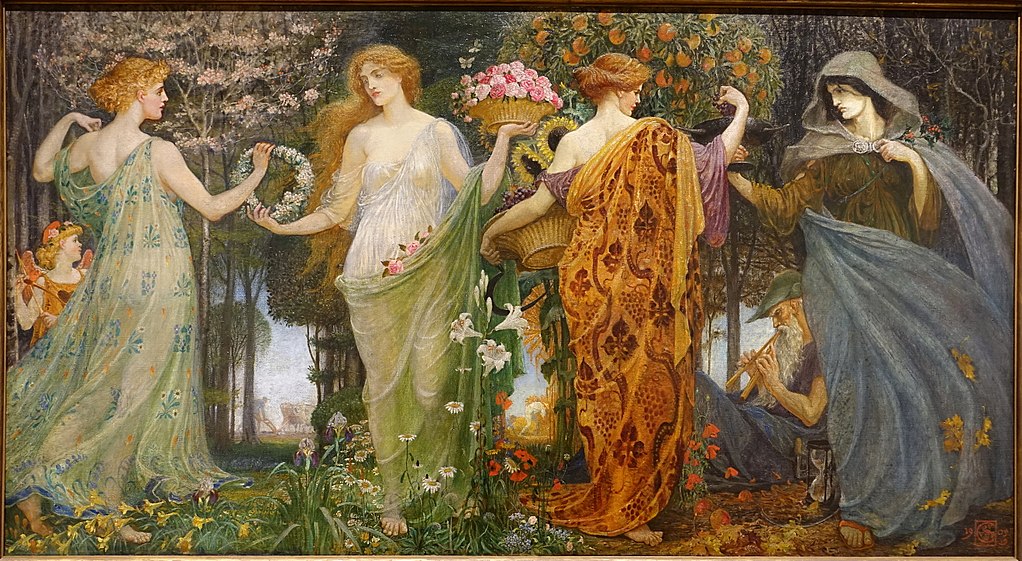Time as a symbol in art
From ancient times to the present day people celebrate the beauty of nature in seasonal rituals. They have special ceremonies with different attributes with flower offerings, fires, and meditations. At a certain point, poetry became a means of expressing people’s feelings. And in their works, poets poured out their souls about the transience of moments. Sensitive to changing seasons, it found expression in the visual arts. Melancholy feelings caused by the feeling of the passing time were the most common emotional notes. This attitude can be seen in the visual season art. Nature itself dictates the seasonally appropriate mood. The spring painting on canvas inspires us to dream with their sweet aroma. Summer day drawing can be filled with bliss and relaxation. And autumn trees hint at the transience of time. Everything changes and nature renews its appearance.
Nature is a woman
The change of seasons is like the mood of a capricious woman. Today you are pampered by the warm sun, and tomorrow it will be covered with cold rain. All four seasons can be transmitted through the female image. One has only to look at the masterpiece of the master Walter Crane. This remarkable artist conveys the changes of nature on canvas.
The masque of the four seasons

The painting “A Masque for the four Seasons” was made between 1905 and 1909.
The four female characters personify the four seasons. Walter Crane’s theme, image proportion, and sequence of the figures were taken from William Morris’ tapestry “The Orchard”, also called “The Seasons”. In addition to the impulses from the Arts and Crafts movement, Walter Crane was also influenced by the Renaissance painting, in particular, Sandro Botticelli’s “Primavera”, as can be seen from the dance movements of the figures and the landscape views.
In this picture, we see the image of four women. Each of them has been drawn by the author separately. Nevertheless, we see that female images are interconnected. They seem to pass on the relay to a friend, how the seasons in nature change. In the first image, Crane painted spring. This image is light and weightless. Even the clothes on the girl are made in translucent tones, exposing purity and purity. Next to her, we see an angel, which is also a symbol of divine holiness. In the hands of an angel holding a bow with an arrow. Perhaps this is a small harbinger of the love that a woman expects with the advent of spring. In the background we see a young man plowing a field. For him, with the advent of spring, everything is also just beginning.
Further, Spring transfers a wreath to the Summer image. Girls traditionally throw wreaths along the river to find out whether love will come to them this year.
Summer is also covered with a gown of cleanliness. The artist uses light colors to depict clothes. Thus, it creates the effect of lightness. This girl picked up flowers and beautifully laid them in a basket. This season is filled with creativity and interesting activities. Summer’s gaze is fixed on the crown of love. Summer awaited her.
Autumn landscape painting. Here we see how the tone of the author’s utterance changes dramatically. He draws the vestments of summer heavier. This dense veil of dark tones. This girl is depicted with her back to the contemplative picture. She is busy with her business. She does not have time for the entertainment of youth. her look is stern.
In the background, we see the figure of a man. He works hard, crouching low to the ground under the burden of work. And he has no time for love.
The final figure in this series of images is the winter. She is harsh. In the face of a woman, we read sadness. Perhaps this is a disappointment because a year has passed and her life was filled with worries. Expectations did not materialize. The clothes of winter are scattered by the wind, a woman holds a cloak so that it does not carry away. Thus, she tries to protect herself from the weather. Only this image we see with shoes on his feet. We can regard this as an allegory that the year has passed and the winter season is ready to hit the road next year.
Behind the winter lady, we see an old man playing the flute. His gaze is also grim. His music is a reflection, meditation. An hourglass is standing nearby. This is a subtle but very striking symbol of the transience of time.
So, in the face of the one who is looking at this picture, the whole life of this year flew by like an instant.
The theme of the seasons was quite popular in European art. People ordered this type of pictures very often. And such seasonal paintings can be found in almost all masters.

The most original is the series of Giuseppe Arcimboldo (1563-1573). It immediately attracted the attention of fans of a wonderful talent. He created the first version of the “Seasons” under Maximillian, in honor of the New Year’s holiday. The second was created already under Emperor Rudolph. By the way, he depicted the ruler himself in the image of Vertumn, the ancient Italian god of the seasons and the gifts of the earth, the god of transformations, metamorphoses and natural abundance.
Despite the unusual pictorial decision, Arcimboldo accurately reflected the spirit of each season. Summer is like a cheerful ruddy old woman; autumn is a serious grandfather. Spring is a cheerful clowness, on whose cheeks a dawn blazes in scarlet and famous winter painting closes the cycle. The theme of old age is illustrated by a dry tree in the image of an old man who wraps in a straw wrap. On the branch are winter fruits: orange and lemon.
Time in art
Painting has much in common with temporary art forms, but this connection is symbolic. Only through the figurative system and imagination, we can “hear” the sound of the painting and “see” the action on the plane of the picture. A person, perceiving a masterpiece and diving into the world of images, restores various images in his imagination. Thus he is dealing with temporary and spatial “transference”.
There are few other indicators of culture. They characterize its essence as much as understanding time. It embodies the spirit of the era, the behavior of people, their consciousness, the rhythm of life. It is time that determines what happened before, what comes later.


